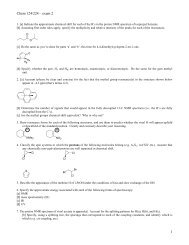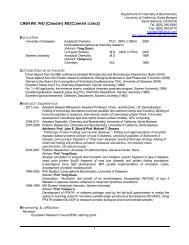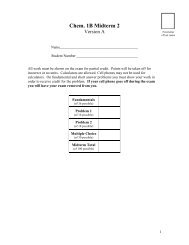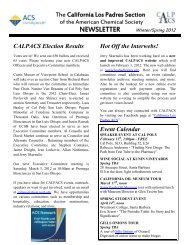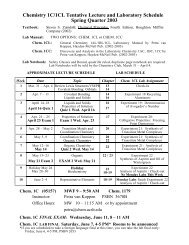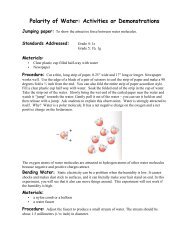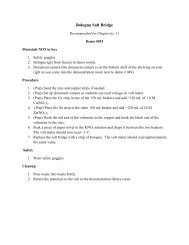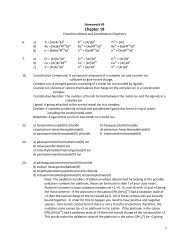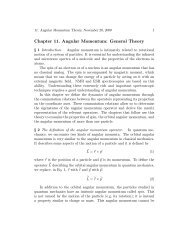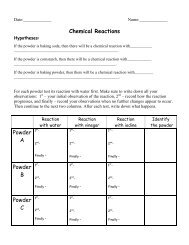Mystery Powders - California K-12 Science Outreach
Mystery Powders - California K-12 Science Outreach
Mystery Powders - California K-12 Science Outreach
Create successful ePaper yourself
Turn your PDF publications into a flip-book with our unique Google optimized e-Paper software.
Grade Level: 5<br />
<strong>Mystery</strong> <strong>Powders</strong><br />
Standards:<br />
1a. Students know that during chemical reactions the atoms in the reactants rearrange to form<br />
products with different properties.<br />
1f. Students know differences in chemical and physical properties of substances are used to<br />
separate mixtures and identify compounds.<br />
1g. Students know properties of solid, liquid, and gaseous substances, such as sugar (C 6 H <strong>12</strong> O 6 ),<br />
water (H 2 O), helium (He), oxygen (O 2 ), nitrogen (N 2 ), and carbon dioxide.<br />
Description: Students will learn about chemical reactions and physical changes through<br />
their investigation of several mystery powders.<br />
Objectives: Students will be able to:<br />
1. Use touch, smell, and sight, to hypothesize what they think each unknown powder is.<br />
2. Work as a team to gather and record information.<br />
3. Correctly identify the unknown powder by testing each powder.<br />
4. Complete each experiment in a safe and responsible manner.<br />
5. Explain the concept of change, both physical and chemical.<br />
Materials:<br />
• Three unknown powders (baking soda, corn starch and baking powder) in salsa cups<br />
or small short Styrofoam cups, labeled A, B and C respectively.<br />
• Nine test tubes (or nine salsa cups) per group<br />
• Three 7.5” wooden coffee stirrers per group (used as a spatula)<br />
• magnifying lenses (optional)<br />
• test tube rack<br />
• three disposable plastic transfer pipettes (you can cut them shorter to stabilize them in<br />
the cups of vinegar, water, iodine solution)<br />
• vinegar in a labeled salsa cup<br />
• dilute iodine solution* in a labeled salsa cup<br />
• water in a labeled salsa cup<br />
• Sharpie, permanent ink marker<br />
*Make the dilute iodine solution using Strong Tincture of iodine available in Longs drug<br />
stores or on-line. It is a reddish brown solution, ingredients: ~7% iodine and 5% potassium<br />
iodide. Fill a small (5-<strong>12</strong> oz) clear juice bottle with water, add drops of iodine until the water<br />
turns the color of filtered apple juice – for best results the solution should be made fresh – the<br />
solution is sensitive to light and will degrade over time – it will have a longer shelf life when<br />
stored in a dark bottle.<br />
Safety: Iodine solution is often used as a topical antiseptic or disinfectant. Students will be<br />
using a very dilute solution of iodine. It is generally non-irritating to the skin but may cause eye<br />
irritation. Spills must be cleaned up immediately. In case of contact with skin, rinse with plenty<br />
of water and wash thoroughly with soap and water.<br />
During the lab, there will be NO eating or drinking allowed. Wash your hands with soap and<br />
water after you complete the experiment.<br />
1
Background:<br />
1. As an introduction to this lesson students will take a pre-video test on the first five<br />
minutes of the video All About Properties of Matter. Students take the quiz answering<br />
with a light pencil mark. Language learners are given extra time to look up all the<br />
vocabulary needed to understand all the questions on the quiz while other students<br />
complete a math worksheet or some other assignment that language learners can<br />
complete at home.<br />
2. As they watch the video, they are required to correct their answers before turning in the<br />
quiz for a final grade.<br />
3. Do Baking Soda/Vinegar activity before doing this lesson.<br />
4. Have students do background reading about chemical and physical properties and about<br />
starches before this lesson. An interesting article for students to read is Keeping Energy<br />
Levels: Emphasize Starchy Foods http://www.urbanext.uiuc.edu/hsnut/hsath1c.html .<br />
5. From student textbook or other sources summarize the evidence of a chemical reaction: a<br />
change in temperature, gas is produced, light is produced, a change in color, a precipitate<br />
forms.<br />
6. Before this lesson, demonstrate that iodine is an indicator for starch. Pick several foods,<br />
which can include rice, wheat, corn, potatoes, or pasta and have students predict if a food<br />
has starch in it before dropping a few drops of diluted iodine on it. Depending on how<br />
diluted your iodine is any food that has starch will turn purple or black. Ask students to<br />
write in their journal which foods contain starch and how they know this. You may want<br />
to include some foods that do not have starch, such as an apple.<br />
7. Hand out copies of the fill-in the blank Chemical Properties song and then play the song<br />
several times as the students make corrections. www.musicallyaligned.com<br />
Vocabulary:<br />
react: to undergo a reaction.<br />
reaction:<br />
a process involving changes of substances.<br />
(a process that changes the molecular composition of a substance by redistributing<br />
atoms or groups of atoms without altering the structure of the nuclei of the atoms).<br />
bubbles: a thin film of something, usually spherical-shaped and filled with air or a gas<br />
vigorous bubbling: strong, energetic or active bubbling<br />
foam: a mass of bubbles of gas or air on the surface of a liquid<br />
foaming: to produce a mass of bubbles<br />
dissolve: to cause to pass into solution: dissolve salt in water<br />
violet: a deep purplish-blue color like that of a violet flower<br />
purple: a dark red-blue color; purple is formed by combining red and blue<br />
solubility: the extent to which one substance is able to dissolve in another<br />
fizz: to produce bubbles of gas<br />
fizzing: the sparkling quality of a drink caused by bubbles of gas (e.g. carbonated drinks)<br />
foamy: covered with, full of, or consisting of foam<br />
2
Procedure:<br />
1. Hand out a copy of the chemical reaction data table to each student.<br />
2. Demonstrate how to take a very small amount of one of the powders on the end of the<br />
wooden spatula and put it in a test tube. Using the sharpie permanent ink marker, students<br />
label the test tube A, B or C for each of the unknown powders – they write the letter directly<br />
on the test tube. Show students the plastic transfer pipette they will use to add a few drops of<br />
water, vinegar or iodine. For each reaction, they are to record all the different phases of the<br />
reaction: 1 st – their initial observation of the reaction, 2 nd – record how the reaction<br />
progresses, and finally – record their observations when no further changes appear to occur.<br />
3. On a food service tray, give each group 3 plastic transfer pipettes, 3 wooden coffee stirrers<br />
(7.5” long), 9 test tubes in a test tube rack, a sharpie pen, and ~2 tsp of each powder in salsa<br />
cups labeled A, B or C (A for baking soda, B for corn starch and C for baking powder).<br />
4. Show students how to look at their reaction data table and label their test tubes using the<br />
sharpie marker. One test tube should read A and H 2 O, another test tube should read B and<br />
H 2 O, etc. Once they have finished labeling their test tubes tell them that they will be testing<br />
the first column, reactions with water.<br />
5. Students use the end of a wooden spatula, to place a small amount of each powder into the<br />
correctly labeled test tubes. After you have verified that students have correctly placed<br />
samples in each of the test tubes, pass out the first liquid, water, in a labeled plastic salsa cup.<br />
Warn students that the most exciting reactions will come with the later liquids and they must<br />
follow instructions and work together to be given the vinegar and the iodine to finish their<br />
testing.<br />
6. Using the transfer pipette students add 4 to 5 drops of water to the first three test tubes<br />
labeled A + H 2 O, B + H 2 O and C + H 2 O. If they observe no reaction, add a few more drops<br />
of water. They must have the first column filled in before they are handed the vinegar to test.<br />
The vinegar is provided in a labeled plastic salsa cup. Provide the iodine solution last, in a<br />
small salsa cup. After all tests are complete, students answer the questions on the worksheet.<br />
Assessment:<br />
Students will be evaluated on how well they fill in the table and answer the questions on the<br />
worksheet. The following day write the following question on the board and ask students to<br />
answer it either on their worksheet or in their journal: If baking powder is made of two<br />
ingredients what are they and how do you know<br />
Extension: Write the following equations on the board. For each equation, ask students<br />
if it is a chemical reaction or a physical change:<br />
1. Boiling water in a teakettle: H 2 O (l) → H 2 O (g)<br />
2. When you put hydrogen peroxide, H 2 O 2 (l), on a cut what do you see Bubbles.<br />
Hydrogen peroxide is a liquid. What state of matter are the bubbles Gas. The bubbles<br />
are due to the formation of O 2 (g). 2 H 2 O 2 (l) → 2 H 2 O (l) + O 2 (g).<br />
3. An ice cube melts: H 2 O (s) → H 2 O (l)<br />
4. NaHCO 3 (s) + CH 3 COOH (aq) → NaCH 3 COO (aq) + H 2 O (l) + CO 2 (g)<br />
baking soda vinegar<br />
Reference: Adapted by Nancy Escamilla and Petra van Koppen from Fitch, Dr. Thomas.<br />
<strong>Mystery</strong> <strong>Powders</strong> Unit Plan. Illinois State University. http://www.iit.edu/~smile/ch9305.html<br />
3
Date:_____________<br />
Name:_____________<br />
Hypotheses:<br />
Chemical Reactions<br />
If the powder is baking soda, then there will be a chemical reaction with____________<br />
________________________________________________________.<br />
If the powder is cornstarch, then there will be a chemical reaction with_____________<br />
_______________________________________________________.<br />
If the powder is baking powder, then there will be a chemical reaction with__________<br />
_________________________________________________________.<br />
For each powder test its reaction with water first. Make sure to write down all your<br />
observations: 1 st – your initial observation of the reaction, 2 nd – record how the<br />
reaction progresses, and finally – record your observations when no further changes<br />
appear to occur. Then continue to the next two columns. After each test, write down<br />
what happens.<br />
Reaction<br />
with water<br />
Reaction<br />
with vinegar<br />
Reaction<br />
with iodine<br />
Identify<br />
the powder<br />
Powder<br />
A<br />
1 st -<br />
2 nd -<br />
1 st -<br />
2 nd -<br />
1 st -<br />
2 nd -<br />
Finally –<br />
Finally –<br />
Finally –<br />
Powder<br />
B<br />
1 st -<br />
2 nd -<br />
1 st -<br />
2 nd -<br />
1 st -<br />
2 nd -<br />
Finally –<br />
Finally –<br />
Finally –<br />
Powder<br />
C<br />
1 st -<br />
2 nd -<br />
1 st -<br />
2 nd -<br />
1 st -<br />
2 nd -<br />
Finally –<br />
Finally –<br />
Finally –<br />
4
How many chemical reactions did you observe and how do you know they were chemical<br />
reactions rather than physical changes<br />
__________________________________________________<br />
__________________________________________________<br />
__________________________________________________<br />
__________________________________________________<br />
________________________<br />
How did you identify the baking soda<br />
__________________________________________________<br />
__________________________________________________<br />
__________________________________________________<br />
__________________________________________________<br />
__________________________________________________<br />
______________________________<br />
How did you identify the cornstarch<br />
__________________________________________________<br />
__________________________________________________<br />
__________________________________________________<br />
__________________________________________________<br />
__________________________________________________<br />
__________________________________________________<br />
__________________________________________________<br />
__________________________________________________<br />
__________________________________________________<br />
__________________________________________________<br />
__________________________________________________<br />
__________________________________________________<br />
__________________________________________________<br />
__________________________________________________<br />
__________________________________________________<br />
__________________________________________________<br />
__________________________________________________<br />
5
Name: _______________________<br />
Date: _______________________<br />
Video Test for first 5 minutes of: All About Properties<br />
of Matter<br />
1. What are all physical objects made of<br />
a) gas<br />
b) metals<br />
c) minerals<br />
d) matter<br />
2. In order to describe matter, we usually list its:<br />
a) physical appearance<br />
b) properties<br />
c) chemical composition<br />
d) smell<br />
3. In science, we describe a substance by comparing it to another substance. We can<br />
compare:<br />
a) its name in English and in Spanish.<br />
b) how many times it is mentioned in a book.<br />
c) its properties.<br />
4. What senses do we use to understand the properties of a substance We use our senses to:<br />
a) see, sound, smell, feel, or taste a substance.<br />
b) try an experiment on a substance.<br />
c) take a substance apart.<br />
6
5. What properties of matter can we see with our eyes<br />
a) shape and sound<br />
b) color and smell<br />
c) size and smoothness<br />
d) color and shape<br />
6. What are some properties of matter we can feel by touching<br />
a) shape, size, color, and smell<br />
b) smoothness, hardness, roughness, and softness<br />
c) heat, texture, sound, and size<br />
7. What properties does all matter have<br />
a) smell, shape, size and color<br />
b) mass, weight, volume, and density<br />
c) reactivity, combustibility and solubility<br />
Physical <strong>Science</strong> for Children[TM]. Schlessinger <strong>Science</strong> Library<br />
Video test created by Nancy Escamilla revised 2007<br />
7
Chemical Properties<br />
Elements account for all __________ in the world.<br />
Like you and me, birds and bees,<br />
Even all the grass and trees are made of ____________ .<br />
You walk down the street and everything you see<br />
is made of ____________ .<br />
Elements, it’s made of.<br />
Each _________ is made of only _______ kind of_______.<br />
In the ______________table all the elements are grouped<br />
by their ______________ properties, properties, properties.<br />
A liquid we all should know, H20, is made of elements.<br />
Elements, it’s made of.<br />
During chemical ____________ some atoms rearrange<br />
(Atoms in reactants)<br />
To form products with different _____________<br />
and different names.<br />
Like in photosynthesis,<br />
_________rearrange and names change.<br />
With chlorophyll, water, sunlight, C02;<br />
They change to __________ and sugar for me and you.<br />
ELEMENTS<br />
8
Chemical Properties<br />
Elements account for all matter in the world.<br />
Like you and me, birds and bees,<br />
Even all the grass and trees are made of elements.<br />
You walk down the street and everything you see<br />
is made of elements.<br />
Elements, it’s made of.<br />
Each element is made of only one kind of atom.<br />
In the periodic table all the elements are grouped<br />
by their chemical properties, properties, properties.<br />
A liquid we all should know, H20, is made of elements.<br />
Elements, it’s made of.<br />
During chemical reactions some atoms rearrange<br />
(Atoms in reactants)<br />
To form products with different properties<br />
and different names.<br />
Like in photosynthesis,<br />
Atoms rearrange and names change.<br />
With chlorophyll, water, sunlight, C02;<br />
They change to sugar and 02 for me and you.<br />
ELEMENTS<br />
9




